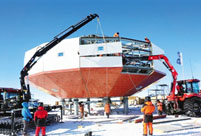 Amazing cliff diving in cold winter
Amazing cliff diving in cold winter
 Enjoy Sochi 2014 in slow motion
Enjoy Sochi 2014 in slow motion
 University student sentenced to death for poisoning roommate
University student sentenced to death for poisoning roommate
 Chinese lunar New Year celebrated in San Francisco
Chinese lunar New Year celebrated in San Francisco
 Taiwan Lantern Festival 2014
Taiwan Lantern Festival 2014
 Haiyang Yangge: make up
Haiyang Yangge: make up
 China's top 10 richest cities
China's top 10 richest cities
 President Xi visits garrison troops in Inner Mongolia
President Xi visits garrison troops in Inner Mongolia
 Turnip sculptures amaze tourists in Qingdao
Turnip sculptures amaze tourists in QingdaoWASHINGTON, Feb. 18 -- U.S. astronomers have used the Hubble Space Telescope to precisely measure the rotation rate of a neighboring galaxy for the first time, U.S. space agency NASA said Tuesday.
The study showed that the central part of the neighboring galaxy, called the Large Magellanic Cloud (LMC), completes a rotation every 250 million years. It takes our sun the same amount of time to complete a rotation around the center of our Milky Way galaxy.
"By using Hubble to study the stars' motions over several years, we can actually, for the first time, see a galaxy rotate in the plane of the sky," said lead author Roeland van der Marel of the Space Telescope Science Institute in Baltimore, Maryland, in a NASA statement.
The researchers said Hubble is the only telescope that can make this kind of observation because of its sharp resolution and its image stability.
"If we imagine a human on the moon, Hubble's precision would allow us to determine the speed at which the person's hair grows," van der Marel explained. "This precision is crucial, because the apparent stellar motions are so small because of the galaxy's distance. You can think of the LMC as a clock in the sky, on which the hands take 250 million years to make one revolution. We know the clock's hands move, but even with Hubble we need to stare at them for several years to see any movement."
For the past century, astronomers have calculated galaxy rotation rates by observing a slight shift in the spectrum, known as the Doppler Effect, of its starlight.
The newly measured Hubble motions and the Doppler motions measured previously provide complementary information about the rotation rate of the LMC, located 170,000 light-years away, NASA said.
"Studying this nearby galaxy by tracking the stars' movements gives us a better understanding of the internal structure of disk galaxies," said co-author Nitya Kallivayalil of the University of Virginia. "Knowing a galaxy's rotation rate offers insight into how a galaxy formed, and it can be used to calculate its mass."
The team next plans to use Hubble to measure the stellar motions in the LMC's diminutive cousin, the Small Magellanic Cloud. NASA said the study should yield improved insight into how the galaxies are moving around each other and around the Milky Way.
The findings were published in the Astrophysical Journal.
 Most gorgeous female celebs in Chi-pao
Most gorgeous female celebs in Chi-pao Second round of test kicks off at Beijing Film Academy
Second round of test kicks off at Beijing Film Academy Ancient Qiang people had vertically grown teeth
Ancient Qiang people had vertically grown teeth Top 10 Chinese youth’s favorite seaside destinations
Top 10 Chinese youth’s favorite seaside destinations Traditional Tibetan clothing tailors
Traditional Tibetan clothing tailors In photos: Unveiling Taishan station
In photos: Unveiling Taishan station Beautiful moments of family reunion
Beautiful moments of family reunion 10 Valentine's Day ideas for couples
10 Valentine's Day ideas for couples Let's get married today!
Let's get married today! Chinese warplanes C919 to appear at Singapore Airshow 2014
Chinese warplanes C919 to appear at Singapore Airshow 2014 Ruins of Shang Dynasty's structure unearthed in Shaanxi
Ruins of Shang Dynasty's structure unearthed in Shaanxi  Intercity high speed train in operation
Intercity high speed train in operation Severe coldness freezes large parts of China
Severe coldness freezes large parts of China  Beautiful moments of Sochi
Beautiful moments of Sochi  It's not just performing this year
It's not just performing this yearDay|Week|Month